

Anticipation Guide. Phonics_research_paper. ReadStrong - Making Words. Making words Making words provides a structured way for students to experiment with words and investigate how the sounds of language are put together (Cunningham, 1994).
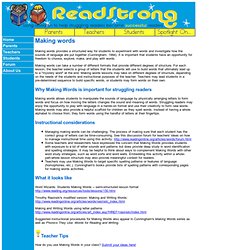
It is important that students have an opportunity for freedom to choose, explore, make, and play with words. Making words can take a number of different formats that provide different degrees of structure. For each lesson, the teacher selects a group of letters that the students will use to build words that ultimately lead up to a "mystery word" at the end. Making words lessons may take on different degrees of structure, depending on the needs of the students and instructional purposes of the teacher. Efferent vs. Aesthetic Reading – WRD320: Writing for Digital Media. Louise Rosenblatt [110] explains that readers approach the work in ways that can be viewed as aesthetic or efferent.
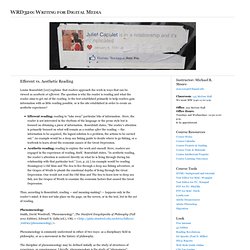
The question is why the reader is reading and what the reader aims to get out of the reading. Is the text established primarily to help readers gain information with as little reading possible, or is the site established in order to create an aesthetic experience? Holistic Scoring Method. Assessment Home | Florida Writes Home Holistic Scoring Method Definition of Holistic Scoring Holistic scoring is a method by which trained readers evaluate a piece of writing for its overall quality.

The holistic scoring used in Florida requires readers to evaluate the work as a whole, while considering four elements: focus, organization, support, and conventions. This method is sometimes called focused holistic scoring. Focus Focus refers to how clearly the paper presents and maintains a main idea, theme, or unifying point. Organization Organization refers to the structure or plan of development (beginning, middle, and end) and whether the points logically relate to one another. Analytic scoring - LiteracyTentWiki. Directed Reading Thinking Activity (DRTA) Sound boxes on Pinterest. Elkonin Boxes. ReadStrong - Neurological Impress Method. Neurological Impress Method (NIM) The Neurological Impress Method is a form of paired reading in which a student and tutor read the same text almost simultaneously.
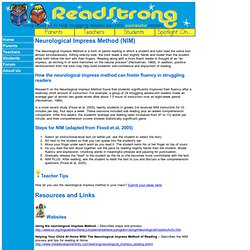
Sitting side-by-side, the tutor reads a text slightly faster and louder than the student while both follow the text with their fingers. Reading along with a more fluent reader is thought of as "an impress, an etching in of word memories on the natural process" (Heckelman, 1969). In addition, positive reinforcement from the tutor may help build students' self-confidence and enjoyment of reading.
How the neurological impress method can foster fluency in struggling readers Research on the Neurological Impress Method found that students significantly improved their fluency after a relatively short amount of instruction. In a more recent study (Flood et al, 2005), twenty students in grades 3-6 received NIM instruction for 10 minutes per day, four days a week. Steps for NIM (adapted from Flood et al, 2005) Teacher Tips. FREE READABILITY FORMULAS TOOLS : FREE READABILITY TESTS FOR YOUR TEXT.
Our Automatic Readability Checker takes a sample of your writing and calculates the number of sentences, words, syllables, and characters in your sample.
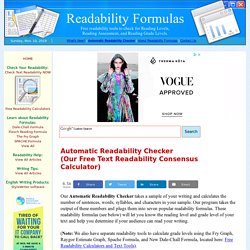
Our program takes the output of these numbers and plugs them into seven popular readability formulas. These readability formulas (see below) will let you know the reading level and grade level of your text and help you determine if your audience can read your writing. (Note: We also have separate readability tools to calculate grade levels using the Fry Graph, Raygor Estimate Graph, Spache Formula, and New Dale-Chall Formula, located here: Free Readability Calculators and Text Tools).
Halliday. Performance Assessment. Performance Assessment By Samuel J.

Meisels, Ed.D. Most standardized tests are not designed to evaluate the individualized growth and development taking place in your classroom. But there are assessment tools that do! Many early childhood educators are uncomfortable with the idea of testing the young children they work with. This is because the assessment tools they know were designed primarily for older elementary-school students. In recent years, however, a new approach to assessment has been gaining acceptance among early childhood and primary grade teachers. They systematically document what children know and can do based on activities they engage in on a daily basis in their classrooms. Back to top. 7.PerformanceAssessment. What is mastery test. Criterion- vs. Norm-Referenced Tests. Source: Huitt, W. (1996).
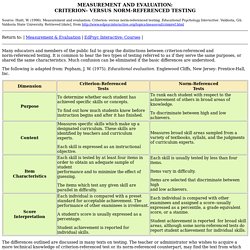
Measurement and evaluation: Criterion- versus norm-referenced testing. Educational Psychology Interactive. Valdosta, GA: Valdosta State University. Retrieved [date], from Return to: | Measurement & Evaluation | EdPsyc Interactive: Courses | Many educators and members of the public fail to grasp the distinctions between criterion-referenced and norm-referenced testing. The following is adapted from: Popham, J. The differences outlined are discussed in many texts on testing.
Additional resources: Shared Reading. Basis for Shared Reading Model The shared reading model was developed by Holdaway (1979).
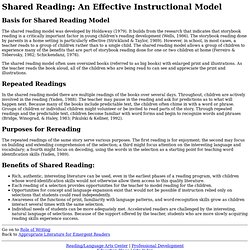
It builds from the research that indicates that storybook reading is a critically important factor in young children's reading development (Wells, 1986). The storybook reading done by parents in a home setting is particularly effective (Strickland & Taylor, 1989). However, in school, in most cases, a teacher reads to a group of children rather than to a single child. Cloze Procedure. ThreeCueingSystems-detail. Literacy Reference - Concepts of Print. Concepts of Print What are Concepts of Print?
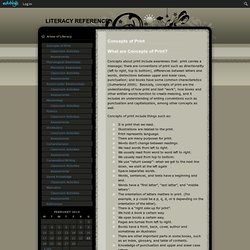
Concepts about print include awareness that: print carries a message; there are conventions of print such as directionality (left to right, top to bottom), differences between letters and words, distinctions between upper and lower case, punctuation; and books have some common characteristics (Sutherland 2000). Basically, concepts of print are the understanding of how print and text “work”; how books and other written words function to create meaning, and it includes an understanding of writing conventions such as punctuation and capitalization, among other concepts as well. Concepts of print include things such as: (Duke, 2008) Also related to concepts of print is the alphabetic principle, the idea that words are composed of letters, and letters represent the sounds we make when we say words. Why are they important? Iri.